Galaxy Science Fiction November 1969: A Retro-Review
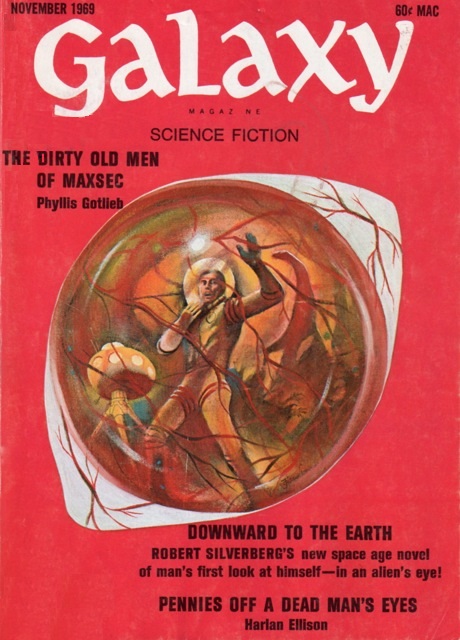 |
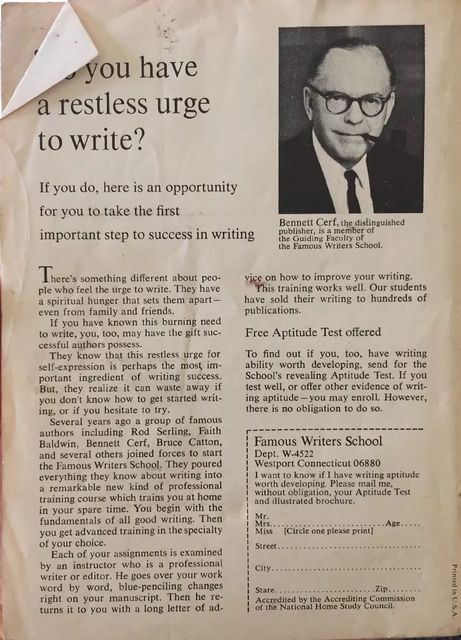 |
This is Part 2 of a Decadal Review of vintage science fiction magazines published in November 1969. The articles are:
Amazing Stories, November 1969
Galaxy Science Fiction, November 1969
The Magazine of Fantasy & Science Fiction, November 1969
Worlds of If, November 1969
Analog Science Fiction/Science Fact, November 1969
Cover by Gaughan, the TOC notes that it was “Suggested from Downward to the Earth.”
Editorial, “Brain Pollution” by Ejler Jakobsson. This delves straight into race issues, in a kind of winking/new-wavy way. There was, it would seem, an article or articles on IQ tests between blacks and whites making waves, with Jakobssen quoting an editorial by John W. Campbell.
If they, (the blacks) basic intelligence pattern is of a different type — naturally it’s harder for them to fit into the Scholarly type that Caucasoids developed — with unquestionable and world-shaking success — so that although they’ve been working into Western culture for as long as time as the Scots, they haven’t been able to fit in anywhere near as well.
Jackobsson doesn’t agree, or at least I don’t think he does. His weird addled-fanboy style makes it hard to tell if he disagrees with the fundamental IQ test issue, or just the way J.W.C. stated it. The former… I think.
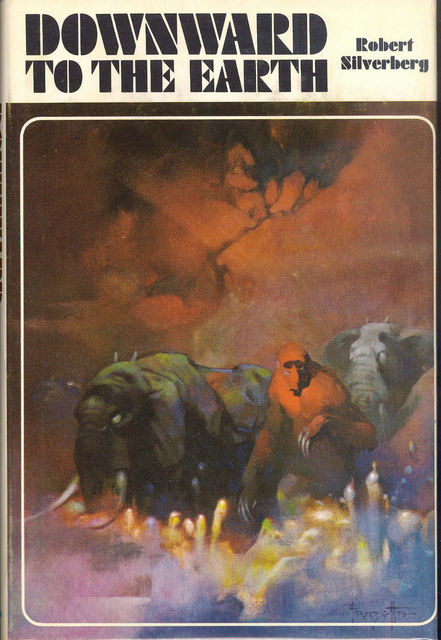 |
 |
| SFBC, 1970 (Frank Frazetta) | Signet, 1971 (Gene Szafran) |
Downward to the Earth, Part 1, by Robert Silverberg. This is an excellent story. MC (main character) Gundersen has returned to Hollman’s World after an absence of eight years. Gundersen was a supervisor of the Company for a decade before the planet was legally turned back to its intelligent species: the elephantine Nildoror, and the yeti-ish Sulidoror. Gundersen has come back to Hollman’s world for reasons that are vague, even to himself. He meets other humans- tourists, some ex-employees still living there, some even still working for the Company. One, Van Beneker:
“When did you leave, exactly?”
“Twenty-two forty. The year after relinquishment. Eight years ago.”
“Eight years. And what have you been doing?”
“The home office found work for me,” Gundersen said. “I keep busy. Now I’ve got a year’s accumulated leave.”
“To spend here?”
“Why not?”
“What for?”
“I’m going up mist country,” Gundersen said. “I want to visit the sulidoror.”
“You don’t want to do that,” said Van Beneker. “Rather — why do you want to do that.”
“To satisfy a curiosity.”
“There’s only trouble when a man goes up there. You know the stories, Mr. Gundersen. I don’t need to remind you of many guys went up there, how many didn’t come back.” Van Beneker laughed. “You didn’t come all the way to this place just to rub noses with the sulidoror. I bet you got some other reason.”
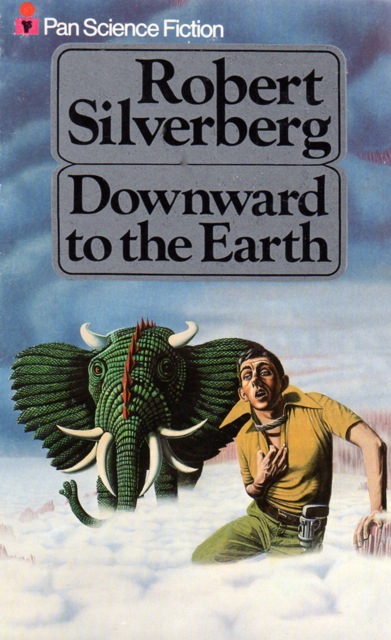 |
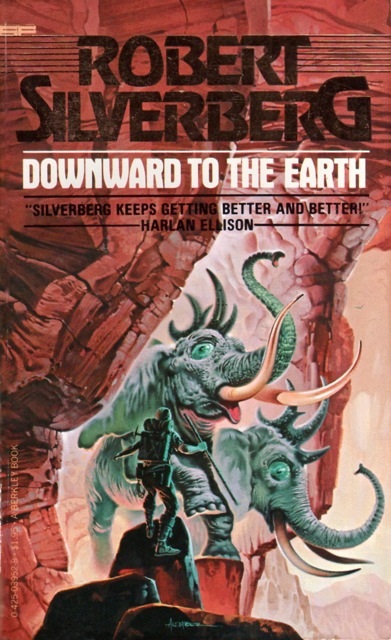 |
| Pan, 1978 (Stuart Hughes) | Berkley, 1979 (Paul Alexander) |
And even though there isn’t that much action, there is a lot going on. It really kind of sucks you in. The planet and the stations now, contrasted with how they were under ownership of the Company, what Gundersen is willing to say and what he isn’t, and his travels (mundane in many ways) from the company of men to the company of the nildoror. A big reveal- one of the commodities the Company is after on Hollman’s world is the venom of a massive worm used in bio-medical application, but people have discovered other uses for it.
During the third week of his stint at the serpent station they finally admitted him to the inner knowledge. Gundersen realized that something unusual was about to happen when he saw Kurtz, after darting a sharp glance at Salamone, unhook a container of venom before it started on its route through the distilling apparatus. He poured it into a broad bowl that held at least a liter of the fluid. On Earth that much of the drug would be worth a year of Gundersen’s salary as an assistant station agent.
The three men stepped outside. At once three nildoror approached, behaving oddly, their spines upraised, their ears trembling. They seemed skittish and eager. Kurtz handed the bowl of raw venom to Salamone, who sipped from it and handed it back. Kurtz also drank.
He gave the bowl to Gundersen, saying, “Take communion with us?”
It borrows heavily from Heart of Darkness (which I haven’t read). I was hooked enough to nose around on Amazon for the next three issues of Galaxy to see it through.
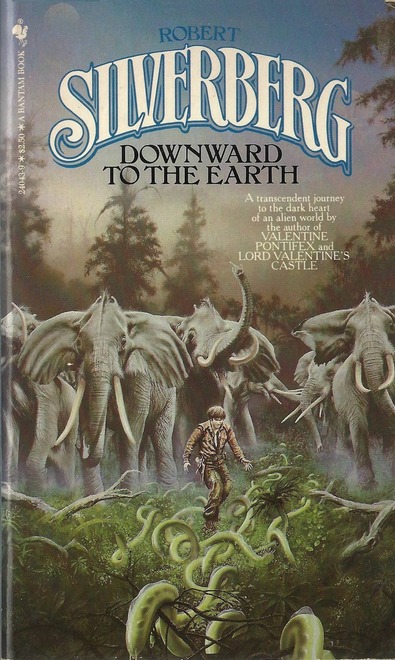 |
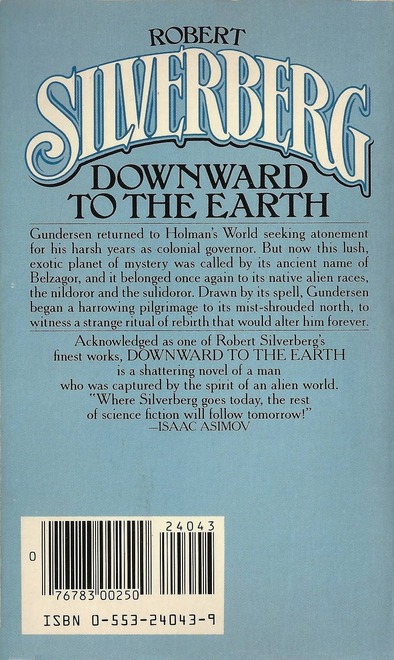 |
Bantam, 1984 (Jim Burns)
“Pennies Off a Dead Man’s Eyes” by Harlan Ellison. So, this is the “new wave” fiction I’ve heard so much about! I suppose Downward to the Earth is an example, too, but “Pennies” seems to be a higher level of the form. Nameless drifter, human-looking but not human, with the ability to go “dark” rolls into a tiny Kansas town to attend the funeral of “Old Jed,” a black man who was of great help to MC and other ‘stray cats’. Intending to pay respects after the funeral, he sees a woman, a white woman, slip in and take the pennies off Jed’s eyes. He pursues her to find out why. While the story wasn’t that great, it did have great writing.
There are some you can meet — the strange, twisted ones — and you know them by an aura, a scent, a feel about them, that if you had one single word — like “junkie” or “nympho” or “hooker” or “Bircher” — a key word that labeled their secret thing, you would understand all the inexplicable, off-center things about them. The one word people. One word and you’ve got the handle on them. One word like “wino” or “diabetic” or “puritan” or —
“Passing?”
“The Dirty Old Men of Maxsec,” by Phyllis Gotlieb. Along with Downward to the Earth, this was the second pleasant surprise of this issue. In the future, the citizens of the City undergo a rejuvenation process, making them essentially immortal. The catch? The reju process jacks with your memories. The undesirables of the society are sent to MaxSec (Maximum Security) and denied the reju process. They are up to something in MaxSec and it is Fenthree’s job to figure out what.
The story has a bit of the “Stagnation of the race!” vibe, and after a bit of a rough start the tale turns out to be quite good. Ms. Gotlieb does excellent work contrasting the bleary, hungover, world of the City against the oddly focused life of MaxSec with its bleary-eyed inhabitants.
The helicopter was sixteen hours away.
Corrigan said, “Mr. Docasta so often lets his feelings get the better of him. I think he might have harmed you if we hadn’t come along, Mr. Fenthree.”
“I didn’t get that impression,” said Fenthree dryly.
“We’ve known him so much longer,” Corrigan murmured. “Now, if you’ll come along with us, I think we can show you something that should please you.”
Fenthree walked with them down the corridor.
He was thinking of furies which had beaten in shuttered hearts for three hundred years, of bitter plans for revenge whispered from hater to hater.
And he was the City personified.
There is no neat solution offered at the end of the story, the situation isn’t “fixed,” the world goes on much as it has, with only the MC really changed.
“How to Kidnap a Moon,” Science Article, by Robert S. Richardson. An article about the technical issues of moving the moons of Mars, Phobos and Demios, to the Earth. Of course, why one would want to do that is not really discussed, nor is the effect of having three moons partially addressed. Still, a decent article, hitting some of the fundamentals of space physics. Also, unlike the Greg Benford/David Book in Amazing, this one had a good number of diagrams and such to walk you through the math.
“Broke, Hungry, and No Place to Go,” by Ron Goulart. The future: food shortages and food riots rock the nation, and the greater L.A. Nutritional office, office worker Marren Milson and super computer Simulator RR-55 decide who gets continued ration allotments and who, well, is executed.
A series of outside riots causes power to be cut and after several days the computer asks for Marren, just to pass the time, to fill out the live/die questionnaire. Not a great story; just why people would willingly fill out forms to determine if they should live or die and then hang around to find out the answer is never addressed. Just how much of the rioting was actually really happening and how much the computer was just f-ing with Marren is left tantalizingly vague.
“For Your Information,” Science Article, Willy Ley. This article is about the extinction of the dinosaurs, exploring the various theories in circulation at the time; a nearby supernova spraying Earth with x-rays and other radiations. He throws in that zoologists had noted that 9,000 years ago there was an extinction event of large mammals, and research from oceanographers re: the flip of the magnetic poles (which would disrupt the earth’s Van Allen belts and thus leave it exposed to cosmic radiation). Long and short, neither a flip nor a supernova would put out enough radiation to do the job. The mammalian extinction was more related to the end of an ice-age and a glacial retreat. Perhaps something similar happened to the dinosaurs? Perhaps! 80 million years ago the last land connection between Brazil and Africa disappeared.
All this must have led to shifts in wind patterns which, in turn, caused climatic changes, changes which made large areas unsuitable for the inhabitants. From the fossil record we can conclude that the end of the Cretaceous period by and large was also the end of the dinosaurs. But we cannot tell how long it took them to die out.
This is a fascinating article, as the idea of a meteorite impact had either not been proposed, or was so fringe as to not be in common circulation.
“Dead End,” by Norman Spinrad. Wily Carson suffers from great ennui in a world of plenty (Weed! Prostitutes! Autostoves!) Machines have taken over most jobs, including his own. Needing a challenge, he takes a trip outside the City to the wilderness area — but before the wall door will let him through, he has to wear an emergency rescue bracelet, which really galls him. He gets to the woods, gets lost, realizes that he hates it here, too, and hits the rescue button — which does not budge. In fact, it was never meant to budge. I’m not sure if this was another ‘The Stagnation of the Race!” kind of story or not.
Galaxy Bookshelf, Book Reviews, A.J. Budrys. Budrys starts off with a great reprint of an article by newspaperman Mike Royko about an old man watching the Apollo 11 lift-off. Jumping off from there he talks about the waning of “Tech Fiction” — but at the same time, there is a new half-ass tech fiction growing, which Budyrs just hates. Also a review of Zelazny’s Creatures of Light and Darkness.
… so, there is a kind of guy (almost always a guy…) in the letters/comments section of SF websites and letters columns, the “carry the 2” guy. The guy who makes constant asides to himself (ex: “Luke struggles just to learn to levitate a light saber. Post-mortem Obi Wan, Master Yoda, carry the two and he is the last great Jedi… I don’t buy it!”). Budyrs is a lot like that. I honestly can’t tell what he’s saying most of the time.
It has what we might call a simple plot. But if we call it that, what do we call a McLean-Poyer plot? Pause. Ah. You could compliment a woman on her simple dress but not her absurd one.
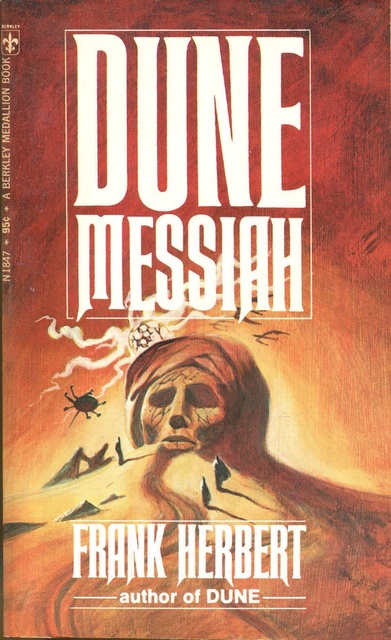 |
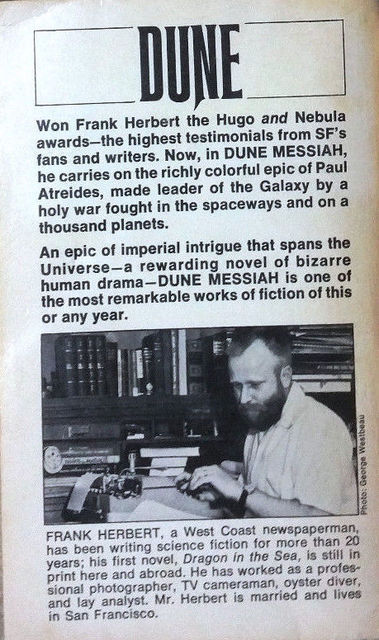 |
Berkley Medallion, 1970 (Jack Gaughan)
“Conclusion of Dune Messiah,” by Frank Herbert. Man, when Galaxy says ‘conclusion’ they mean it. This is not even the last chapter of the novel, more like the last scene. Normally, I don’t have a problem with spoilers on 47-year-old stories, and I don’t have one now! Blind Paul Atreides gets the drop on his enemies by mind-melding with one of his newborn children. Ba-da-boom, crystknife in the eye, mofo! Paul celebrates by wandering into an approaching sandstorm to have the flesh torn from his bones, as per prophecy.
Comparing Galaxy to Amazing Stories, Galaxy is clearly on top. But the SF field, so used to being ahead of its time, found itself being hemmed in by reality. The U.S. had started landing probes on the Moon in 1966, with the first manned landing in July of 1969 — mere months before this issue — and the second manned moon landing happening the same month as this issue. The future, it seems, was starting to arrive.
BUT! The old problems still existed, and this issue of Galaxy seemed to delve deep into race and racism; from the opening shot of the editorial, to the treatment of Nildoror and Sulidoror in Downward to the Earth, “Pennies off A Dead Man’s Eyes” is almost exclusively about racism, and it is implied that most of the people killed by Milson and Simulator RR-55 in “Broke, Hungry and no place to go” were likely black.
Adrian Simmons is an editor for Heroic Fantasy Quarterly. His last article for us was a Retro Review of the November 1969 issue of Amazing Stories.
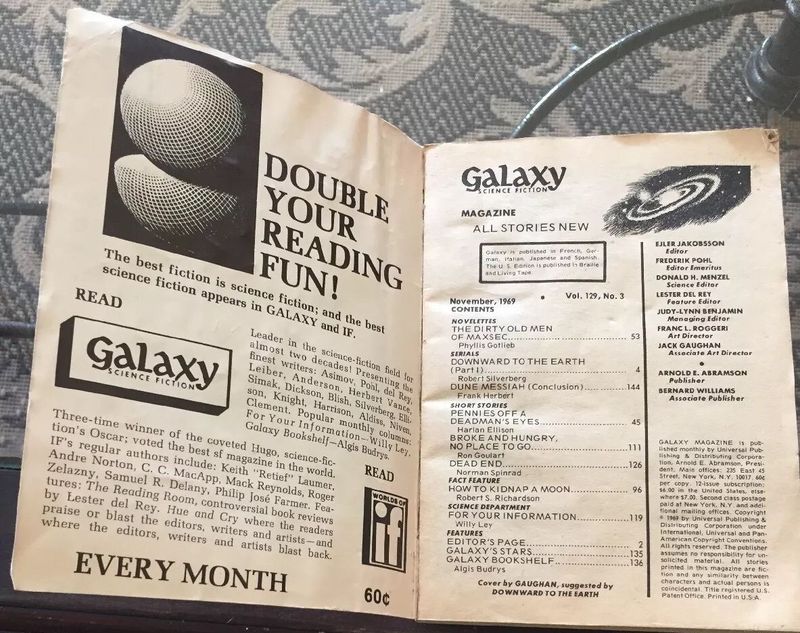
Very nice review of this issue. At age 14, I didn’t buy this issue, though I probably noticed it and might have picked it up and looked it over. That was the era of Gaughan! I’d say this cover was one of his less appealing efforts, though.
Downward to the Earth is, I think, Silverberg’s best novel.
[…] Fiction (Black Gate) Galaxy Science Fiction November 1969: A Retro-Review — “Comparing Galaxy to Amazing Stories, Galaxy is clearly on top. But the SF […]
Major,
I agree that this was a weaker Gaughan cover. He ran fairly hot and cold for me in general… some of his Ace Double covers are spectacular, and more than a few I find downright ugly.
Yeah, the cover was not that great, although I didn’t think it was that bad.
Thomas Parker- I’ve only read a little Silverberg, but “Downward to Earth” was so good that I actually bought the next four Galaxy magazines to read it all.
[…] Fiction (Black Gate) Galaxy Science Fiction November 1969: A Retro-Review — “Comparing Galaxy to Amazing Stories, Galaxy is clearly on top. But the SF […]